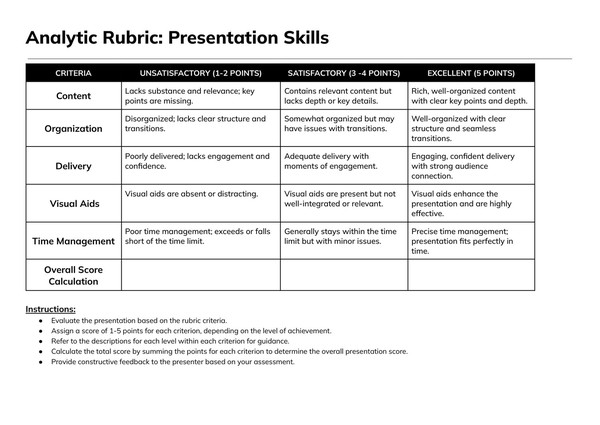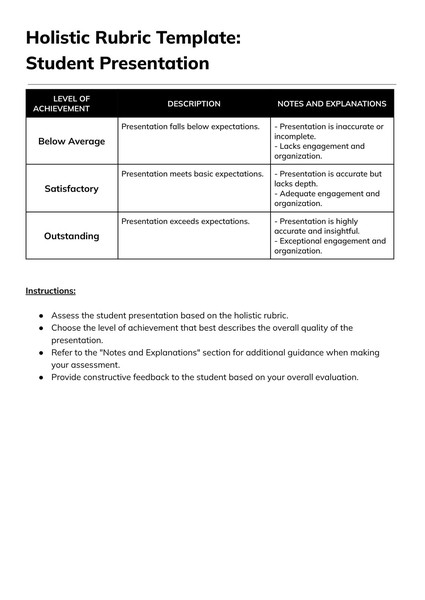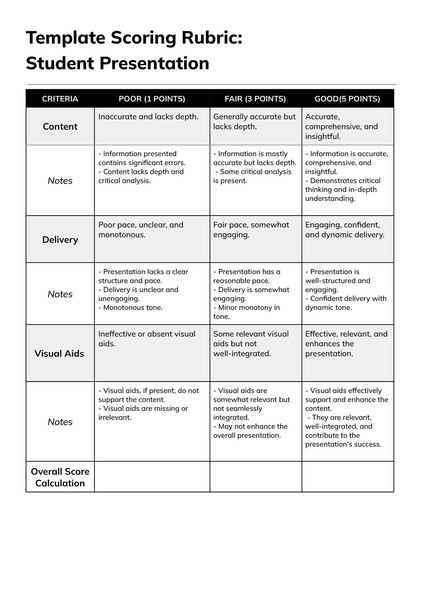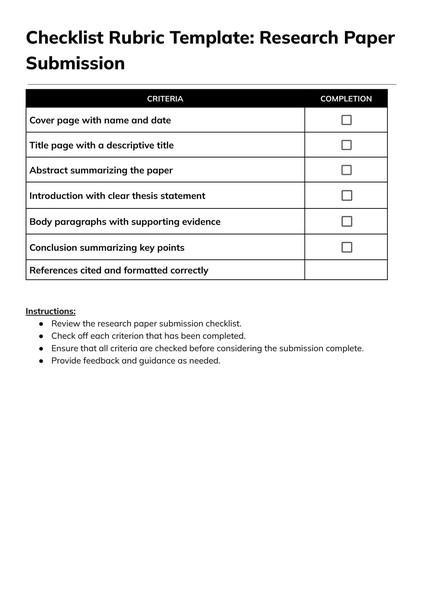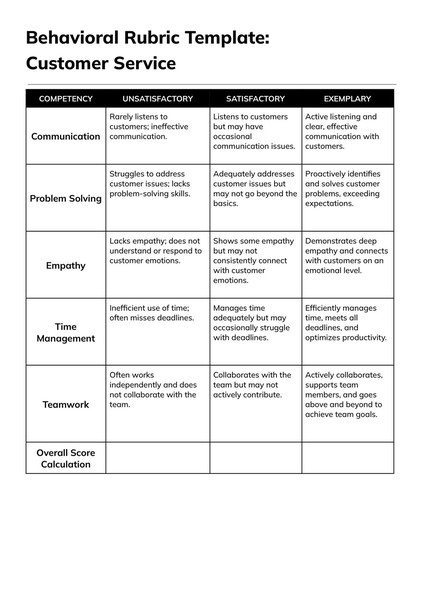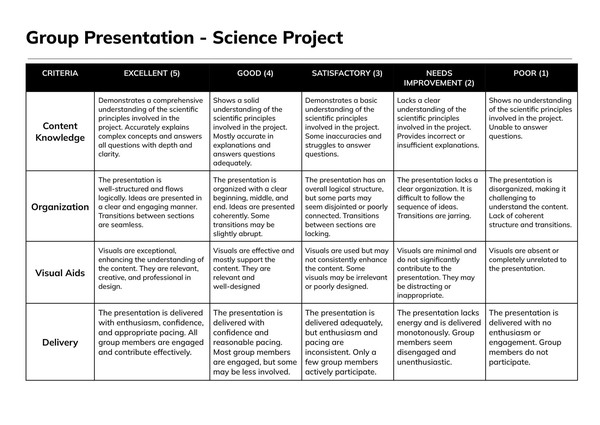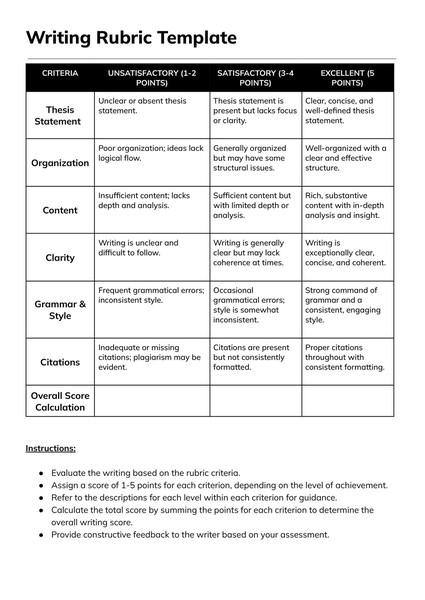When it comes to evaluating and assessing various tasks, rubrics are invaluable tools. They provide a structured way to grade or evaluate assignments, projects, or performances. Google Docs is a widely used platform for document creation and collaboration, and it's a convenient choice for creating and sharing rubrics. In this article, we'll explore the top seven rubric templates that you can use in Google Docs to streamline your assessment process.
Table of Contents
- Analytic Rubric
- Holistic Rubric
- Scoring Rubric
- Checklist Rubric
- Behavioral Rubric
- Group Project Rubric
- Writing Rubric
How to Get Started with Google Docs Rubric Template
Getting started with our template is quick and easy. Follow these simple steps:
-
Access the Template: Click on link below each template image to access the template in Google Docs.
-
Make a Copy: To use the template, click on button "Use Template" in the top right corner." This action will create a duplicate of the template in your Google Drive.
Note: You must be logged in your Google account. -
Customize: Open the copied template in Google Docs and customize it to your liking. Add your organization's logo, adjust fonts and colors, and make any necessary changes to the structure to match your meeting requirements.
-
Save and Share: Once you've customized the template, save it in your Google Drive. You can easily share it with your team members, allowing everyone to access and use the template for their meetings.
Analytic Rubric Google Docs Template
Analytic rubrics break down assessments into specific criteria and levels of achievement. They are well-suited for providing detailed feedback on various aspects of a task or assignment, making them a versatile choice for educators and evaluators.
Holistic Rubric Google Docs Template
Holistic rubrics, on the other hand, provide a broad, overall assessment of a task. They are ideal for situations where you want to evaluate the entire work as a whole. Holistic rubrics are often used in scenarios where a detailed breakdown isn't necessary.
Scoring Rubric Google Docs Template
Scoring rubrics are perhaps the most common type used in education. They assign numerical scores to assignments, making them easy to calculate and understand. These rubrics are great for assessments where you want to quantify performance.
Checklist Rubric Google Docs Template
Checklist rubrics are simple and straightforward. They consist of a list of criteria or tasks that need to be completed, and each criterion is binary—either it's checked (completed) or unchecked (not completed). Checklist rubrics are handy for ensuring tasks are completed systematically.
Behavioral Rubric Google Docs Template
Behavioral rubrics are often used in professional settings to evaluate behaviors and competencies. They assess specific behaviors or actions expected in a job role, making them valuable tools for employee evaluations and development.
Group Project Rubric Google Docs Template
Group projects are common in educational and professional settings. Group project rubrics assess teamwork, collaboration, and individual contributions within a group. They are essential for ensuring fair evaluations in group assignments.
Writing Rubric Google Docs Template
Writing rubrics are particularly crucial for evaluating written assignments, essays, and reports. They focus on aspects such as clarity, organization, grammar, and content. Writing rubrics help provide structured feedback to improve writing skills.
Incorporating these rubric templates into Google Docs can streamline your assessment process and help you provide clear and consistent feedback to students or colleagues. To use them effectively, simply copy and paste the template into your Google Docs document, customize it to your specific needs, and start assessing with ease.
Rubrics not only make the grading process more efficient but also offer a transparent and fair way to evaluate performance. Whether you're an educator, manager, or team leader, these rubric templates can help you maintain consistency and provide valuable feedback in various assessment scenarios.
So, which rubric template suits your assessment needs best? Let's dive into each type in more detail to help you make an informed choice.
FAQ
1. Can I modify these rubric templates to suit my specific needs?
- Absolutely! Rubric templates in Google Docs are highly customizable. You can adjust criteria, descriptions, and scoring to align with your assessment goals.
2. What is the main difference between scoring and analytic rubrics?
- The key difference lies in how they evaluate tasks. Scoring rubrics provide an overall score, often numeric, for an entire assignment, while analytic rubrics break down the assessment into specific criteria and levels of achievement.
3. When should I use a scoring rubric, and when should I opt for an analytic rubric?
- Use a scoring rubric when you want to assign a single numeric score to an assignment and focus on the overall quality.
- Choose an analytic rubric when you need to evaluate and provide detailed feedback on various aspects or criteria within an assignment.
4. Can I use both scoring and analytic rubrics for the same assessment?
- Yes, you can use both rubric types if it suits your assessment goals. Start with an analytic rubric to evaluate specific criteria, and then use a scoring rubric to summarize the overall score.
5. How do I decide which rubric type is best for a particular assignment?
- Consider the nature of the assignment: Analytic rubrics are suitable for complex assignments with multiple criteria while scoring rubrics work well for straightforward assessments.
- Think about the level of detail required: If you need to provide in-depth feedback on various aspects, choose an analytic rubric.
6. Can I create my own custom rubric that combines elements of both scoring and analytic rubrics?
- Yes, you can create a hybrid rubric that combines aspects of both types to suit your specific assessment needs. Tailor it to the criteria and goals of your assignment.
